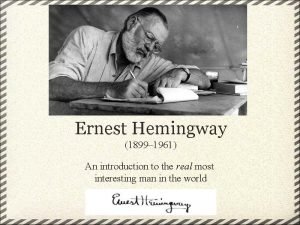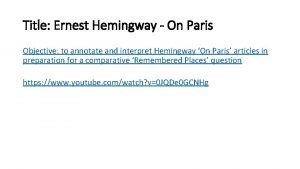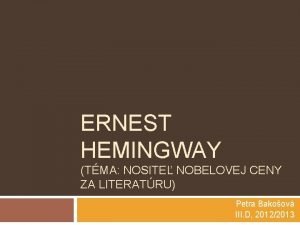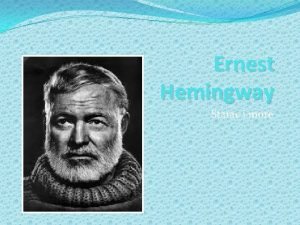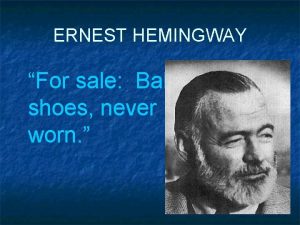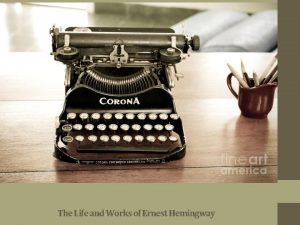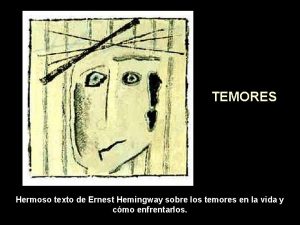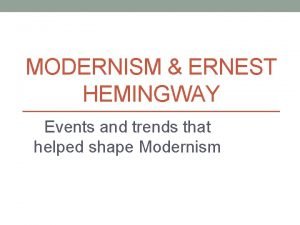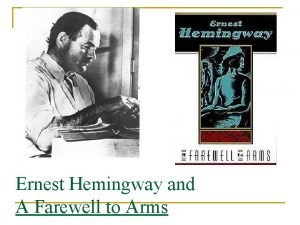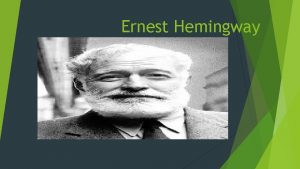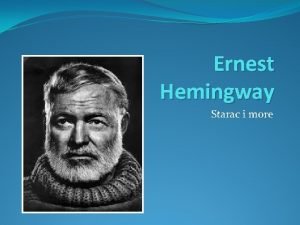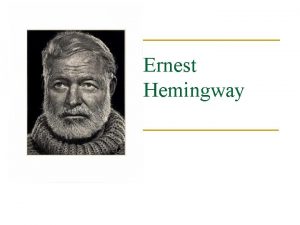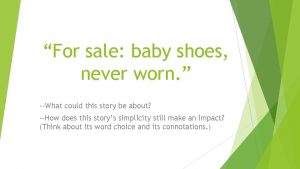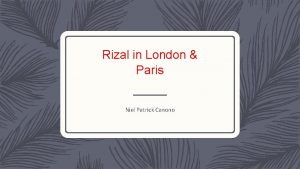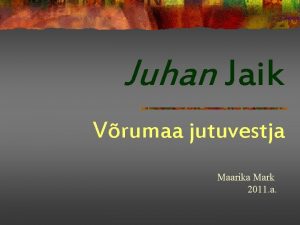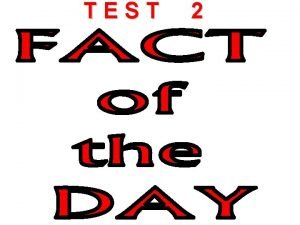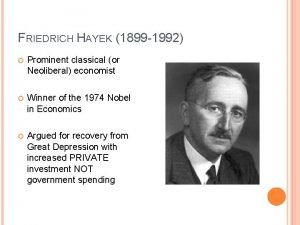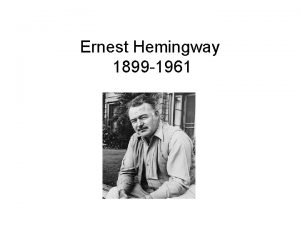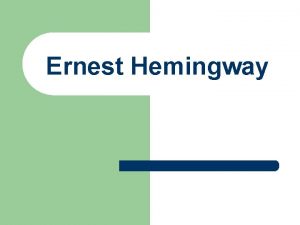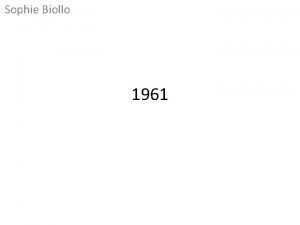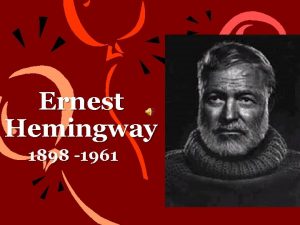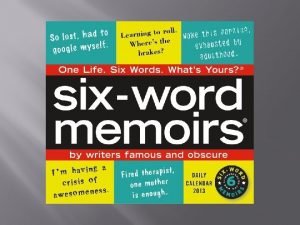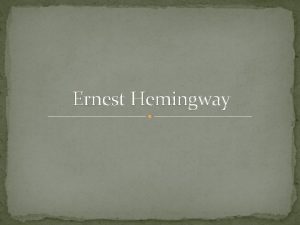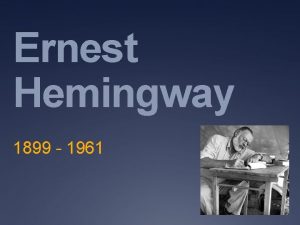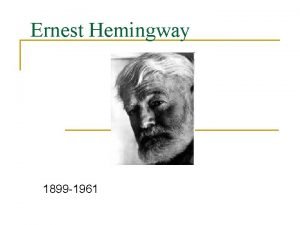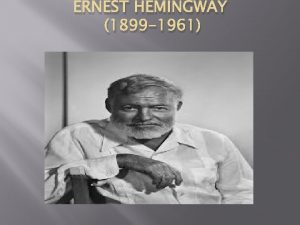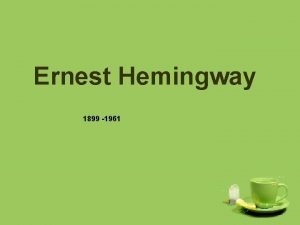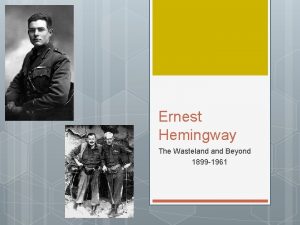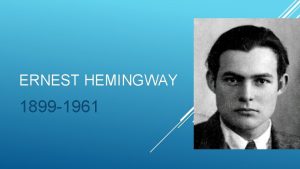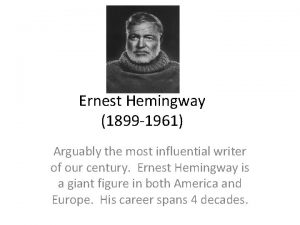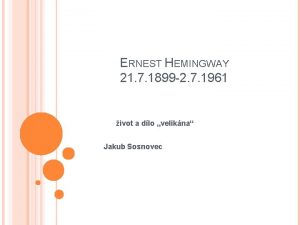Ernest Hemingway 1899 1961 An introduction to the






















- Slides: 22

Ernest Hemingway (1899– 1961) An introduction to the real most interesting man in the world

"This is to tell you about a young writer named Ernest Hemingway, who lives in Paris. . . has a brilliant future. I'd look him up right away. He's the real thing. " -F. Scott Fitzgerald to his editor Max Perkins, 1924

Who is Ernest Hemingway? He was an American author and journalist. Writer of seven novels, two nonfiction accounts of his experiences in Spain and Africa, and numerous short stories and articles His best known work is his novel A Farewell to Arms, 1929 Won the Pulitzer Prize for The Old Man and the Sea, 1952 Won the Nobel Prize in Literature in 1954

Early Life Born in Oak Park, Illinois in 1899. One of six children of Clarence and Grace Hemingway. His conservative parents were not ready for the sexual openness of his novels. Later, when his first novel The Sun Also Rises was to be discussed at his mother's book club, she was not present.

Early Life Ernest and his family spent summers at Walloon Lake in Michigan. These outings gave him an early appreciation for wild terrain and inspired the settings for some of his short stories.

Early Life He attended Oak Park and River Forest High School from 1913 -1917 where he took part in a number of sports— boxing, track and field, water polo, and football and had good grades in English classes. After graduation he moved to take a job as a reporter with the Kansas City Star. In 1918 he entered World War I as a member of the Red Cross Ambulance Corps His experience in WWI inspired his novel A Farewell to Arms.

Paris Married Hadley Richardson in 1922 and moved to Paris, where he worked as a foreign correspondent. Wrote short stories and his novel The Sun Also Rises which got favorable reviews in 1926. In 1926 Hemingway and Richardson separated and he met Pauline Pfeiffer, whom he married in 1927 Met F. Scott Fitzgerald in Paris 1925; Fitzgerald had just published The Great Gatsby.

Bullfighting In 1923, Hemingway saw his first bullfight in Pamplona, Spain. The sport became one of his life's passions. This inspired his novel The Sun Also Rises.

Spain In 1937 Hemingway worked as a reporter covering the Spanish Civil War. Met writer Martha Gellhorn whom he married in 1938 after his divorce from Pauline.

Spain His war experiences in Spain inspired "one of the major novels in American literature, " For Whom the Bell Tolls. As a reporter, he liked being part of the action. Here, Hemingway helps a Loyalist soldier unjam his rifle

Africa Big game hunting became another of Hemingway's life's passions

Africa On safari in 1953, drinking heavily, he took up with a native girl while his wife was shopping in Nairobi. He shaved his head in the name of "going native", dyed his clothes a rusty color to match the hue favored among the local Masai people, and went hunting with a spear.

Deep-sea fishing Hemingway enjoyed fishing off Key West. By the mid 30 s he became known as one of the best-known fishermen in America.

World War II When war broke out, Hemingway moved from Key West to Cuba, where he convinced the Cuban government to help him refit his ship The Pilar for ambushing German submarines.

World War II Not satisfied, he went to Europe from June- December 1944 and was present at the D-Day invasion. Supposed to be merely an observer, "Hemingway got into considerable trouble playing infantry captain to a group of Resistance people that he gathered because a correspondent is not supposed to lead troops, even if he does it well. " -Historian Paul Fussell Met fourth wife Mary Welsh in 1946. In 1947 awarded a Bronze Star for bravery in combat.

Later Years A heavy drinker all his life, Hemingway's health began to fail. Growing increasingly depressed, paranoid and unstable in his later years, he was admitted to the Mayo Clinic in Minnesota in 1960 where he received up to 15 rounds of electroshock therapy. July 2, 1961, following several rounds of electroshock therapy, he "quite deliberately" shot himself with his favorite shotgun.

Later years Life magazine published the novella The Old Man and the Sea in a single issue in 1952, and within 48 hours, all 5. 3 million copies were sold. Hemingway received the Nobel Prize for Literature in 1954

"For a true writer each book should be a new beginning where he tries again for something that is beyond attainment. He should always try for something that has never been done or that others have tried and failed. Then sometimes, with great luck, he will succeed. " -Hemingway upon receiving the Nobel Prize, 1954




"I always try to write on the principle of the iceberg. There is seven-eights of it under water for every part that shows. Anything you know you can eliminate and it only strengthens your iceberg. It is the part that doesn't show. " -Ernest Hemingway, 1958
 Hemingway
Hemingway On paris ernest hemingway analysis a level
On paris ernest hemingway analysis a level Invictus reflexion
Invictus reflexion Ernest hemingway nobelova cena
Ernest hemingway nobelova cena Starac i more kompozicija
Starac i more kompozicija Starac im ore
Starac im ore Baby shoes never worn hemingway
Baby shoes never worn hemingway Ernest hemingway life and works
Ernest hemingway life and works Ernest hemingway temia
Ernest hemingway temia Who is the protagonist in hills like white elephants
Who is the protagonist in hills like white elephants Hemingway modernist
Hemingway modernist Hemingway code hero a farewell to arms
Hemingway code hero a farewell to arms Ernest m hemingway
Ernest m hemingway Ernest hemingway djela
Ernest hemingway djela Ernest hemingway was born in oak park
Ernest hemingway was born in oak park Robert jordan postava
Robert jordan postava For sale baby shoes never worn meaning
For sale baby shoes never worn meaning Biscuit mold by rizal
Biscuit mold by rizal Kirjanik 1899-1948
Kirjanik 1899-1948 Claude monet 1899 london
Claude monet 1899 london Horace taylor, the verdict, september 25, 1899
Horace taylor, the verdict, september 25, 1899 Themes of heart of darkness
Themes of heart of darkness Friedrich hayek (1899-1992)
Friedrich hayek (1899-1992)
